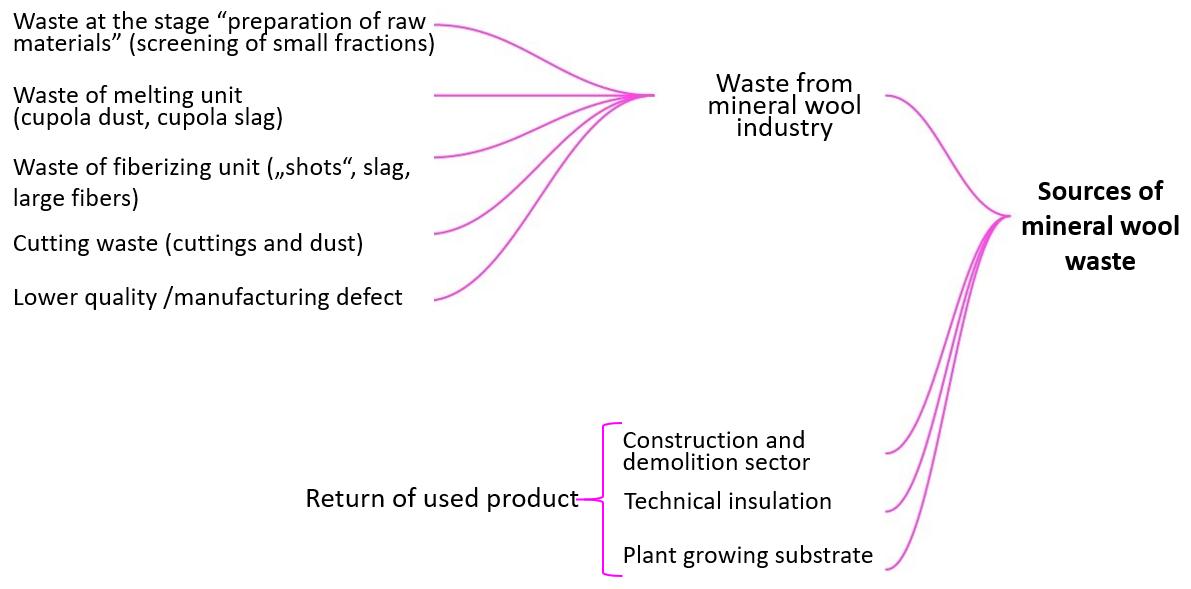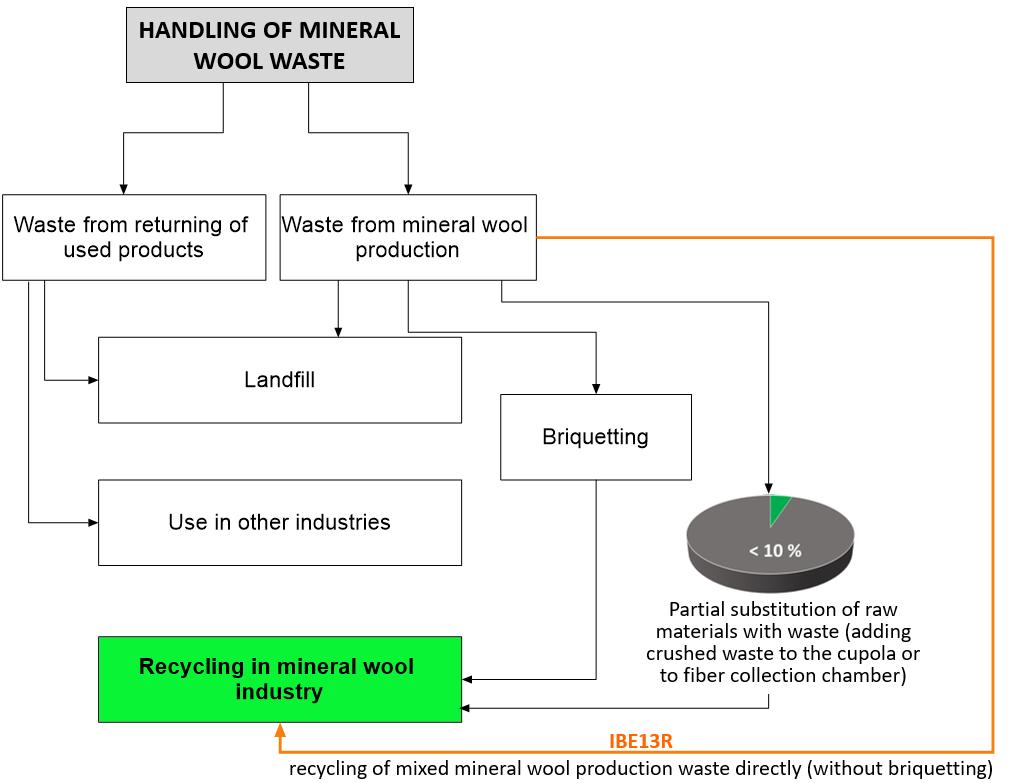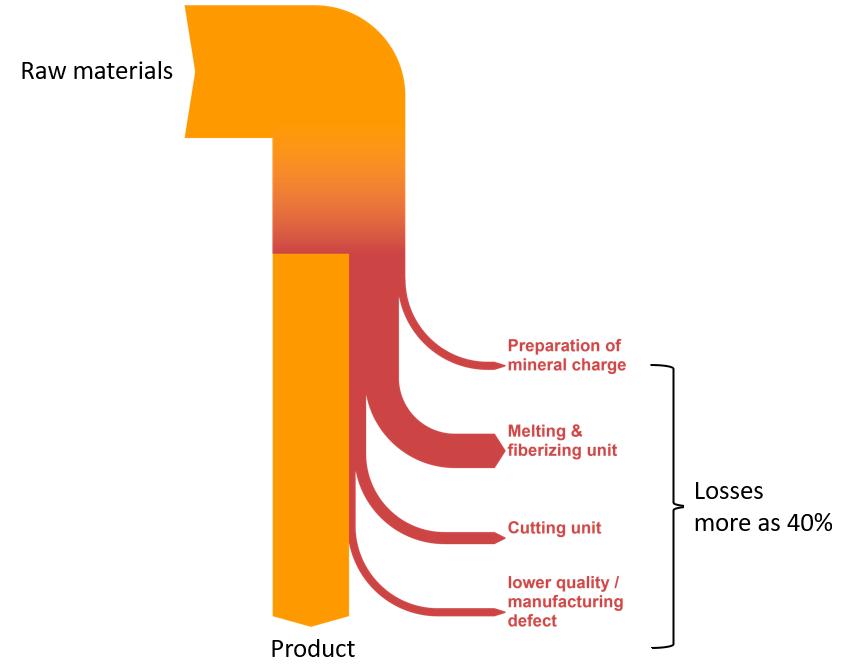
Recycling of Mineral Wool Waste
Authors: Katharina Grass, Victor Bartashov, Jurgen
Sucker
IB Engineering GmbH, Vienna, Austria
19.03.2021
Mineral wool waste in Europe accounts for 20 to 60% of
the production volume. In practice, this means 160,000 to 480,000 tons of waste
from 40 production lines, in average 20,000 t/a per line. [2]. Considering that
the yearly increase of industrial production, the volume of stored waste is
constantly growing. Expenses for removal and disposal of industrial mineral
waste are immensely high (on the average, 8–10% of the value of manufactured
products [3]).
1.
Types and sources of mineral wool waste
The major sources of mineral wool
waste are listed below:
- mineral
wool industry,
- construction
and demolition sector,
- technical
insulation,
- substrate
for growing plants.
The production of mineral wool insulation
accumulates a large amount of industrial waste at different stages of
production process:
- waste at the stage of
raw material preparation (screening),
- waste of melting unit
(cupola dust, cupola slag),
- waste of fiberizing
unit (shots, slag, large fibers),
- cutting waste
(cuttings and dust) and

Fig. 1: Types and sources of mineral wool waste
Additionally, in accordance with the Commission
Directive 97/69 / in EU, mineral wool is classified according to the degree of
carcinogenic danger in the so-called "old" and "new"
mineral wool.
Primarily, this concerns the return of used mineral
wool products (construction and demolition sector, technical insulation, etc.).
Since 2000, Europe has banned the production and use of biopersistent
mineral fibers. Thus, for “old” mineral wool produced before 2000, stricter
disposal rules are applied. Due to its carcinogenic effect, “old” mineral wool
cannot be recycled in mineral wool production.
2. Handling of mineral wool waste
Currently three main directions of the subsequent use
of mineral wool waste can be specified: landfill, recycling in mineral wool
production and use in other industries.

Fig. 2: Main directions of mineral wool waste handling
2.1. Landfill
Landfill is the
easiest way in the practice of waste handling, though it has several
disadvantages. For manufacturers of mineral wool products, these are, on the
one hand, the loss of valuable raw materials that can be used in manufacturing
a new insulating product, thus gaining profit (see Fig. 3).

Fig. 3: Material losses from waste in the production
of mineral wool insulation materials
On the other hand, abstaining form waste recycling causes high additional costs for disposal and transport.
The expenditures for the landfill of mineral wool waste in recent years has
increased significantly in several countries. For example, the landfill fee, a
few years ago in Germany amounted to 40 / 50 euros per ton. At present, the
costs for waste disposal on landfills is approx. 225 euros / t [4].
Furthermore, inefficient use of non-renewable, easily accessible natural
resources (basalt, dolomite, etc.) leads to their rapid depletion, as well as
to accumulation of a large amount of waste. The latter, in turn, creates an environmental problem, having a negative
impact on soil, surface- and underground water and occupying vacant land areas.
Depositing mineral wool waste is technically difficult due to its large
volume, low bulk density, high elasticity, poor compressibility and,
consequently, lack of stability at the landfill [5].
2.2. Possibilities of using mineral wool waste in other
industries
When solving the issue of disposal of
"old" mineral wool, numerous attempts were made to use mineral wool
waste in other industries. Existing research on this topic emphasizes the applications in which potentially carcinogenic fibers are
destroyed or reliably bound. Scientific studies have been done on the use of mineral wool
waste in following areas:
- in cement industry [6], [7], [8],
- in production of ceramics, including building ceramics [3], [9],
[10],
- in wood-based
composites in combination with wood waste [11], [12],
- for backfilling in the mining industry [13],
- as a filler in composites based on cement or gypsum [14], [15].
- in the production of refractory concrete [16].
The difficulties in introducing these applications consist in the absence of proven technologies and the
necessary equipment, as well as in the imperfection of the waste management
system, including the organization of collection, sorting
and preparation of waste.
2.3. Recycling of waste in mineral wool industry
From the point of view of a circular economy, the
return of waste back to mineral wool production is the best solution, occupying
the second place in waste management hierarchy after waste prevention [17]. Remelting of mineral wool waste modifies such hazardous characteristics as morphology and
chemistry during melting and solidification process [18]. In addition,
replacing primary raw materials with secondary ones reduces the energy
consumption for smelting, thus making the process more economical.
One of the difficulties in reprocessing of mineral
wool waste is, however, a high content of small waste,
such as dust or shots. In the standard technology including cupola
furnace, lump raw materials with a size of about 100 mm are used. Feeding a
large amount of small waste can lead to blockage of air supply [18].
Therefore, the most common way to return small
waste back to the cupola furnace is the preliminary formation of briquettes
[19]. When briquetting, the waste is ground to a
homogeneous mass, mixed with cement and water, then formed into briquettes in a
hydraulic press, dried in a drying chamber and reused in the process of
producing mineral boards as one of the charge components [20].
Theis method, however, presents certain problems.
At high temperature the briquettes bound with cement split into small pieces
before the melting process starts, thereby making remelting in the cupola
furnace impossible because of the interrupted feeding of air and gases [21].
Furthermore, the melting of briquettes containing cement causes more significant
emissions of solid particles and sulfur oxides into the atmosphere than the
melting of virgin rock [2]. Hydraulic binders based on clay and liquid glass
are also not optimal for briquetting, because the strength of such briquettes
decreases at a temperature of about 500°C [1]. Briquettes containing clay-based binder have poor
moisture resistance and tend to absorb water and break down during storage
[22].
From the industrial point of view, briquetting is a
costly, intermediate process that requires additional material, energy, and
human resources.
In the framework a research program one of European
companies has developed a method for feeding mineral wool waste obtained in a
centrifuge and crushed to a fraction of 0–6 mm directly into a cupola furnace
[2]. With this method, a maximum of 10% substitution of the virgin rock can
be achieved.
Another known equipment for recycling of mineral
wool waste is focusing exceptionally on waste from edge trimmings and
manufacturing defect. Here the crushed waste is partially added to the product
in the fiber collecting chamber [23]. Same as in the previous method, the percentage of substitution of the
primary raw material is limited, so this option cannot be used for a large
amount of waste.
Summarizing the topic of recycling mineral wool
waste and its use in manufacturing of mineral wool products, the following
conclusions can be drawn:
- currently, there is no
possibility of processing mixed waste: none of the methods is designed to
process all types of industrial waste. Even with briquetting, it is
impossible to achieve the complete disposal of all waste.
- There is no
possibility of processing a large amount of waste directly, without
briquetting. The partially feeding of waste into
cupola furnace or fiber collecting chamber can enable to recycle only a
very small percentage of waste.
Finally, it should be noted that all known methods of
reusing the waste in production are currently applicable mainly to industrial
waste, the chemical composition of which is known. Thus, a few mineral wool manufacturers recycle exclusively the used
mineral wool insulation of own production [24]. The composition and condition of mineral insulation waste removed during
the demolition or renovation of buildings, are, in most cases, unknown [1]. Therefore, due to strict requirements to chemical composition of mineral wool in the European Union, the reusing
of such waste in production is currently considered unacceptable (see paragraph
1 and Fig. 2).
A few companies outside the European Union do not strictly divide mineral wool in "old" and "new", offering the
disposal of old mineral wool from construction site [25].
3. Conclusion: the main
reasons of irrational use of mineral wool waste
Regarding the above analysis, it can be concluded
that one of the main reasons for the irrational use of industrial mineral wool
waste is the lack of technologies and equipment that would allow to process
a wide range of waste at minimal cost.
Our company has approached this challenge by
developing an innovative technological solution. The technological line IBE13R designed by IB Engineering GmbH
allows to recycle a wide range of mineral wool waste at minimal cost, while
meeting the high requirements of resource efficiency and environmental
protection (link: EQUIPMENT AND
TECHNOLOGY FOR RECYCLING MINERAL WASTE)
References:
1
Väntsi O., Kärki T. (2014):
Mineral wool waste in Europe: a review of mineral wool waste quantity, quality,
and current recycling methods; Journal of Material Cycles and Waste Management,
Bd. 16, pp. 62-72.
2
Karppinen, K. (2002).: Paroc-WIM—Waste
injection into the stone wool melting furnace—LIFE02 ENV/FIN/000328, https://ec.europa.eu/environment/life/project/Projects/index.cfm?fuseaction=home.showFile&rep=laymanReport&fil=LIFE02_ENV_FIN_000328_LAYMAN.pdf, [Accessed:
02.02 2021].
3
Abdrakhimov V.Z. (2019): Use of mineral wool waste in the
production of ceramic wall materials, Samara State University of Economics, Vestnik PNGSPU. Construction and architecture, Samara,
Russia, https://www.researchgate.net/publication/342650277_THE_USE_OF_WASTE_MINERAL_WOOL_IN_THE_PRODUCTION_OF_CERAMIC_WALL_MATERIALS,
[Accessed:14.02.2021].
4
Vogdt А. et al. (2019):
LifeCycle KMF Optimierung der Stoffströme im Lebenszyklus von Bauprodukten aus
künstlichen Mineralfaserdämmstoffen, Fraunhofer IRB Verlag.
5
Sattler T. et al. (2020): Mineral wool waste in austria,
associated health aspects and recycling options, https://digital.detritusjournal.com/articles/mineral-wool-waste-in-austria-associated-health-aspects-and-recycling-options/285, [Accessed:
28.01.2021].
6
Yliniemi J. et al. (2019): Mineral wool waste-based geopolymers;
Fiber and Particle Engineering Research Unit, University of Oulu, Finland;
Saint-Gobain, Finland.
7
Sattler T., Vollprecht D. and Pomberger R.
(2020): Stoffliche Verwertung von Mineralwolleabfällen
in der Zement- und Mineralwolleindustrie, https://www.vivis.de/wp-content/uploads/2020/11/342-355_Sattler.pdf, [Accessed:11.02.2021].
8
Kubiliute R., Kaminskas R., Kazlauskaite A.
(2019): Mineral wool production waste as
an additive for Portland cement Department of Silicate Technology, Kaunas
University of Technology, Kaunas, Lithuania, http://iranarze.ir/wp-content/uploads/2018/06/E7895-IranArze.pdf,
[Accessed:14.02.2021].
9
Pranckeviceine, J.; Balkevicius, V.; Spokauskas, A. (2010): Investigation on properties of
sintered ceramics out of low-melting illite clay and
additive of fine-dispersed nepheline syenite. Medziagotyra,
pp. 231-235.
10
Kizinievič O. et al. (2014): Investigation of the usage of
centrifuging waste of mineral wool melt (CMWW), contaminated with phenol and
formaldehyde, in manufacturing of ceramic products, Waste Management 34(8), pp.
1488-1494.
11
Jetsu P., Vilkki M., Tiihonen I. (2020): Utilization of demolition wood and
mineral wool wastes in wood-plastic composites, Finland; detritus
-Multidisciplinary Journal for Waste Resources & Residues.
12
Maminski, M.; Krol, M.; Jaskolowski, W.; Borysiuk, P. (2011):
Wood-mineral wool hybrid particleboards. European Journal of Wood and Wood
Products, 69 iss. 2, pp. 337-339.
13
Gröper,
J.; Lack, D. (2016): Verfahren zur Verwertung von Dämmmaterialabfällen aus
Mineralwolle in Spezialbaustoffen. In: Pomberger, R.u.a. (Hrsg.): Tagungsband zur 13. Recy
& Depotech-Konferenz, Leoben: AVW (Eigenverlag),
pp. 161-166.
14
An Cheng, Wei-Ting Lin, Ran Huang (2011): Application of rock wool waste
in cement-based composites; Materials & Design; Volume 32, Issue 2,
pp.636-642.
15
Babaev D.D., Zavadko M.Yu., Petropavlovskaya V.B.
(2020): Solutions in the field of waste disposal from the production of basalt
fibers; magazine "ISSUES OF SUSTAINABLE DEVELOPMENT OF SOCIETY", pp .: 431-436, 2020. Federal State Budgetary Educational
Institution of Higher Education "Tver State
Technical University", Russia, Tver.
16
Stonys R.et al. (2016): Reuse of ultrafine mineral wool production
waste in the manufacture of refractory concrete, Research article, Journal of
Environmental Management 176, pp. 149-156.
17
WKO
Kreislaufwirtschaft:
https://www.wko.at/service/umwelt-energie/kreislaufwirtschaft.html, https://digital.detritusjournal.com/articles/mineral-wool-waste-in-austria-associated-health-aspects-and-recycling-options/285,
[Дата обращения: 28.01.2021]
18
Sattler T., Galler
R. Vollprecht
D. (2019): Entwicklung innovativer
Recyclingverfahren für Mineralwolleabfälle – Projekt RecyMin; BHM Berg- und Hüttenmännische
Monatshefte volume 164, pp. 552–556.
19
Vollprecht, D. et al. (2019):
Innovative Landfilling and Recycling of Mineral Wool Waste as Backfill
Material, in the Cement Industry and in the M ineral
Wool Industry; Mineralische Nebenprodukte
und Abfälle 6; pp. 480-492, https://www.vivis.de/wp-content/uploads/MNA6/2019_MNA_480-493_Vollprecht, [Accessed:
10.01.2021].
20
Kataev D. (2018): 10 years under quality mark; https://ksonline.ru/333966/10-let-pod-znakom-kachestva/, [Accessed: 14.01.2021].
21
BALKEVIČIU, et al.: Analysis of some properties of model system
from low-melting illite clay and fibrous mineral wool
waste; Institute of Thermal Insulation, Vilnius Gediminas Technical University,
https://materialsscience.pwr.edu.pl/bi/vol25no1/articles/ms_2006_036.pdf,
[Accessed: 14.01.2021].
22
PAROC GROUP (2002): EP0546000B2; Process for mineral wool production.
23
FAS Hansek GmbH & Co KG: Mineral wool
recycling equipment: http://basalt-online.ru/section-equipment/recycling-of-mineral-wool-is-a-sophisticated-tool-that-combines-increased-profits-and-environmental, [Accessed:11.02.2021].
24
Vogdt
F. et al. (2019): Leitfaden Recyclingpotential von Mineralwolle, TU Berlin,
https://www.irbnet.de/daten/rswb/19089008967.pdf, [Accessed:
03.02 2021].
25
TECHNONICOL NEWS; http://fasad-rus.ru/news_end_new.php?id=4409, [Accessed: 12.02.2021].